Welcome to our guide on the “Alaskan Malamute Price in India.” If you’re considering bringing home an Alaskan Malamute, it’s essential to understand various factors that contribute to its price and make an informed decision. Alaskan Malamutes are magnificent and powerful dogs known for their strength, endurance, and striking appearance.
Originally bred as sled dogs, they have gained popularity as loyal and loving family companions. However, acquiring an Alaskan Malamute involves certain considerations, including their cost, care requirements, and availability in India. In this article, we will delve into the Alaskan Malamute price in India, factors affecting the cost, and the essential information to help you decide if this breed is the right fit for you.
- Average Alaskan Malamute Price In India
- Alaskan Malamute Price In different cities in India
- Different types of Alaskan Malamutes
- Overview of the Alaskan Malamute breed
- Physical and behavioral traits of Alaskan Malamutes
- History of Alaskan Malamutes
- Factors Affecting Alaskan Malamute Price In India
- Additional costs associated with owning an Alaskan Malamute
- Tips for finding a reputable breeder in India
- Where to find Alaskan Malamutes for sale in India
- Caring for Alaskan Malamute In India
- Final Thoughts
- FAQs
Average Alaskan Malamute Price In India
The average Alaskan Malamute price in India can vary depending on several factors such as the breeder’s reputation, the dog’s lineage, the quality of the breed, and the region where you are purchasing the dog. On average, you can expect to pay between ₹60,000 to ₹1,50,000 for an Alaskan Malamute puppy in India.
It’s important to note that this is just an average Alaskan Malamute Price in India, and the actual cost may be higher or lower depending on the aforementioned factors. Additionally, Alaskan Malamute Prices in India may vary from one breeder to another, so it’s crucial to research and find a reputable breeder who prioritizes the health and well-being of their dogs.
Keep in mind that the cost of purchasing an Alaskan Malamute is just the beginning. Owning a dog comes with ongoing expenses such as food, grooming, veterinary care, and other essentials. It’s essential to consider these factors and ensure you are financially prepared to provide for the needs of an Alaskan Malamute before bringing one home.
Alaskan Malamute Price In different cities in India
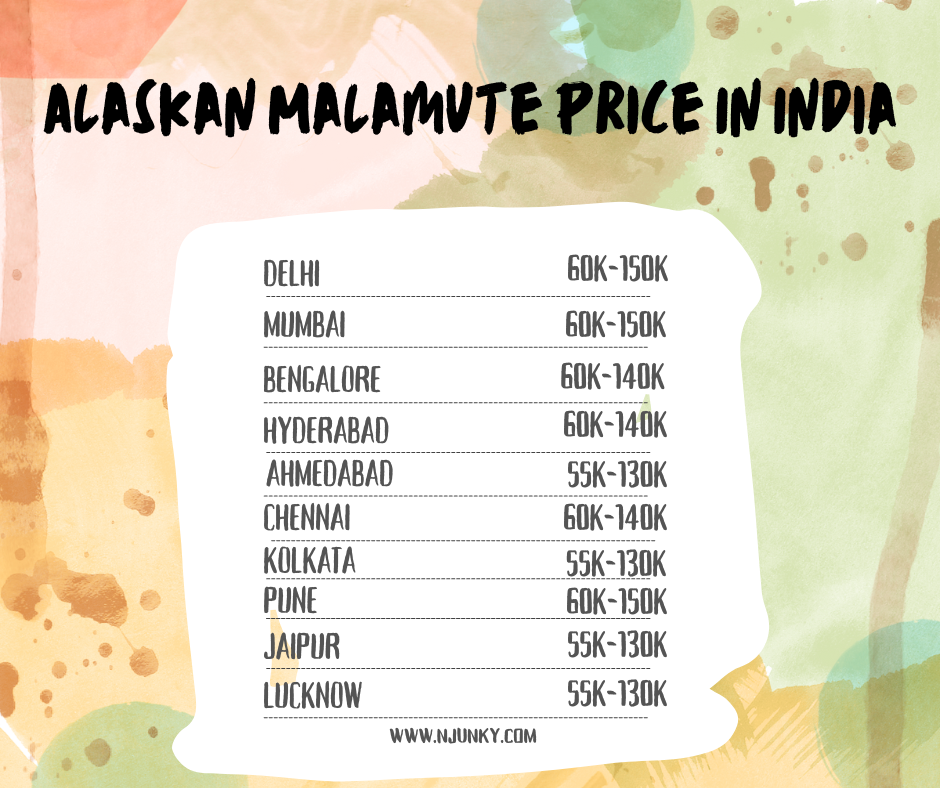
Are you interested in bringing home an Alaskan Malamute? If so, it’s important to have a clear idea of the cost associated with this majestic breed. And that’s where our table comes in – we’ve compiled prices for Alaskan Malamutes across various cities in India. By referring to this table, you’ll have a better understanding of budgeting for your furry friend.
| No | City | Average Price Range (INR) |
| 1 | Alaskan Malamute Price In Mumbai | 60,000 – 1,50,000 |
| 2 | Alaskan Malamute Price Delhi | 60,000 – 1,50,000 |
| 3 | Alaskan Malamute Price In Bangalore | 60,000 – 1,40,000 |
| 4 | Alaskan Malamute Price In Kolkata | 55,000 – 1,30,000 |
| 5 | Alaskan Malamute Price Chennai | 60,000 – 1,40,000 |
| 6 | Alaskan Malamute Price In Hyderabad | 60,000 – 1,40,000 |
| 7 | Alaskan Malamute Price In Pune | 60,000 – 1,50,000 |
| 8 | Alaskan Malamute Price Ahmedabad | 55,000 – 1,30,000 |
| 9 | Alaskan Malamute Price In Jaipur | 55,000 – 1,30,000 |
| 10 | Alaskan Malamute Price In Lucknow | 55,000 – 1,30,000 |
| 11 | Alaskan Malamute Price Chandigarh | 60,000 – 1,40,000 |
| 12 | Alaskan Malamute Price In Bhopal | 55,000 – 1,30,000 |
| 13 | Alaskan Malamute Price In Indore | 55,000 – 1,30,000 |
| 14 | Alaskan Malamute Price In Kochi | 60,000 – 1,40,000 |
| 15 | Alaskan Malamute Price In Guwahati | 55,000 – 1,30,000 |
Different types of Alaskan Malamutes
When it comes to Alaskan Malamutes, there is typically one recognized breed standard for the Alaskan Malamute, which describes the desired physical and behavioral traits. However, within this breed, you may come across variations in terms of size, coat color, and working ability. Here are some different types or variations of Alaskan Malamutes:
- Standard Alaskan Malamute: This refers to the Alaskan Malamutes that conform closely to the breed standard set by kennel clubs and breed organizations. They have the typical size, coat color, and overall appearance expected for the breed.
- Giant Alaskan Malamute: Some Alaskan Malamutes may be larger in size than the average breed standard. These dogs are often referred to as “Giant Alaskan Malamutes” and may have more substantial bone structure and weight.
- Woolly-Coated Alaskan Malamute: While most Alaskan Malamutes have a thick double coat, some individuals may have an especially plush and long coat. These dogs are known as “Woolly-Coated Alaskan Malamutes” and often have more abundant fur around their body, including a fuller ruff and bushy tail.
- Red Alaskan Malamute: While the standard coat colors for Alaskan Malamutes are typically shades of gray, black, or sable, it is possible to find individuals with a reddish coat. These dogs are known as “Red Alaskan Malamutes” and have a coat that ranges from light copper to deep red tones.
Overview of the Alaskan Malamute breed
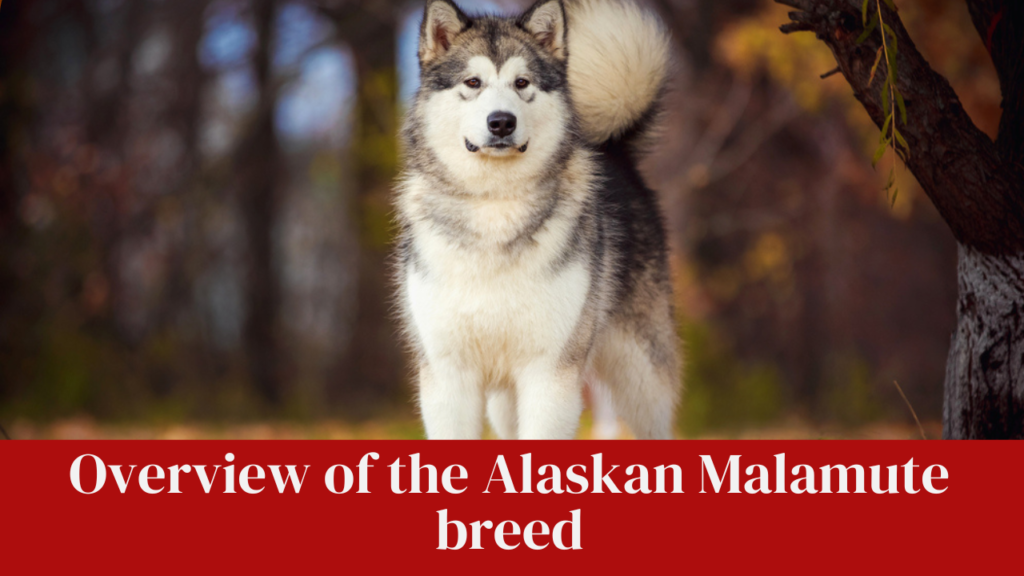
The Alaskan Malamute is a large breed of dog that originated in Alaska, where it was used as a sled dog and for hunting. They are known for their strength, endurance, and loyalty.
Appearance: Alaskan Malamutes have a thick, double coat that is typically gray, black, or sable. They have a broad heads, erect ears, and a plumed tail that is held over their back. They are large and muscular, weighing between 75-100 pounds and standing between 22-26 inches tall.
Temperament: Alaskan Malamutes are friendly and affectionate dogs that make great family pets. They are loyal and protective of their owners and are known for their gentle disposition. They are also highly intelligent and can be stubborn, so early training and socialization are important to ensure they become well-behaved members of the family.
Activity level: Alaskan Malamutes are highly active dogs that require a lot of exercises. They were bred to pull sleds for long distances, so they have a lot of energy and need daily exercise and mental stimulation to keep them happy and healthy. They do well in a home with a large fenced yard where they can run and play, and they also enjoy hiking and other outdoor activities with their owners.
Health: Alaskan Malamutes are generally healthy dogs, but they can be prone to certain health issues, including hip dysplasia, bloat, and eye problems. Regular veterinary check-ups and a healthy diet and exercise regimen can help prevent these issues.
Physical and behavioral traits of Alaskan Malamutes
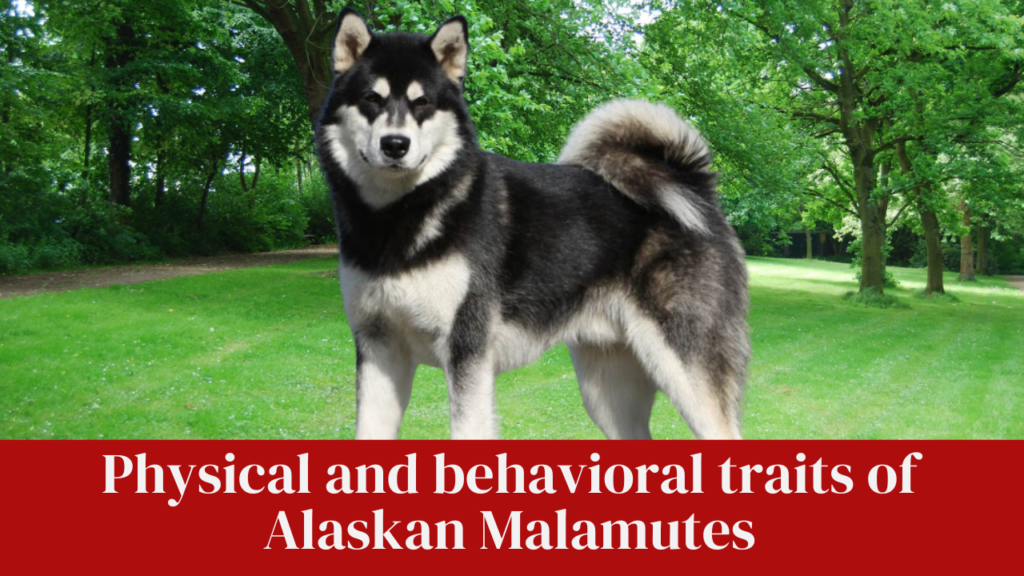
Alaskan Malamutes possess distinct physical and behavioral traits that make them unique. Here are some of the notable characteristics of Alaskan Malamutes:
Physical Traits:
- Size and Build: Alaskan Malamutes are large and robust dogs. They typically have a powerful, muscular build with a deep chest and strong legs. Adult males typically weigh between 75 to 100 pounds (34 to 45 kilograms), while adult females weigh slightly less, ranging from 65 to 85 pounds (29 to 39 kilograms).
- Coat: They have a thick double coat designed to withstand cold temperatures. The outer coat is coarse and oily, providing protection against moisture, while the undercoat is dense and insulating. Alaskan Malamutes come in various coat colors, including shades of gray, black, sable, and red, often with distinctive markings on the face and body.
- Facial Features: They have a broad head with erect, triangular ears that help them maintain body heat. Their eyes are almond-shaped and set obliquely, usually in shades of brown. Alaskan Malamutes often have friendly and expressive facial expressions.
- Tail and Feet: Their tail is well-furred and curls over their back, which helps keep their face warm when they curl up to sleep. Their feet are large, sturdy, and equipped with thick pads, allowing them to navigate rugged terrains with ease.
Behavioral Traits:
- Friendly and Affectionate: Alaskan Malamutes are known for their friendly and affectionate nature. They form strong bonds with their family members and are generally good with children and other pets if properly socialized from an early age.
- Independent and Strong-Willed: Alaskan Malamutes have a strong independent streak and can exhibit stubbornness at times. They are intelligent dogs but may require patience and consistent training methods to respond effectively.
- Energetic and Active: These dogs have high energy levels and require regular exercise and mental stimulation. They have a strong instinct for pulling and enjoy activities like hiking, jogging, and participating in dog sports such as sledding, weight pulling, or obedience trials.
- Gentle and Good-Natured: Alaskan Malamutes are generally gentle and have a calm disposition. They are not typically aggressive but can be protective of their family and territory.
- Howling and Vocalization: Alaskan Malamutes are known for their distinctive howling and vocalization. They often communicate through various vocal sounds and may howl in response to certain stimuli or to express their emotions.
History of Alaskan Malamutes
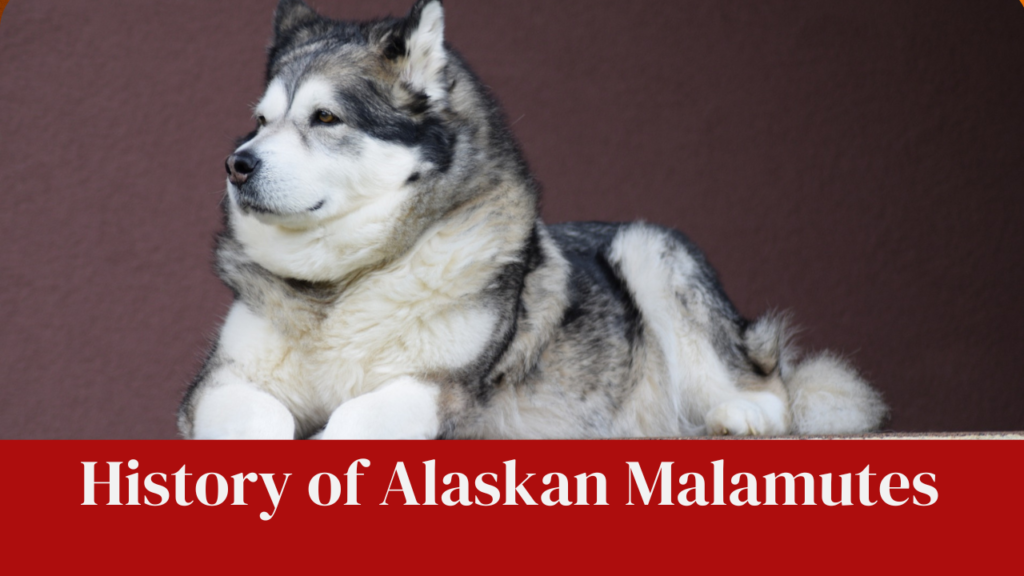
The Alaskan Malamute is one of the oldest Arctic sled dogs, originating from the Mahlemut tribe in Alaska. These dogs were used for transportation and to help the tribe hunt and survive in the harsh Arctic environment.
The history of the Alaskan Malamute can be traced back to more than 4,000 years ago when the Inuit people of Alaska first began breeding them. The Mahlemut tribe, in particular, bred Alaskan Malamutes as sled dogs, using them for transportation and as a means to hunt seals and other wildlife. The Mahlemut people relied heavily on these dogs for their survival in the harsh Arctic environment.
The breed was further developed in the late 19th century by American explorer and sled dog racer, William Goosak. He bred Alaskan Malamutes with other breeds, including Siberian Huskies and Samoyeds, to create a faster and more agile sled dog.
During the early 20th century, Alaskan Malamutes were used extensively in sled dog racing, and the breed gained popularity in the United States. In 1925, a group of Alaskan Malamutes were used to transport life-saving serum to the town of Nome during an outbreak of diphtheria. This heroic effort became known as the “Great Race of Mercy” and solidified the breed’s reputation as a hardworking and dependable sled dog.
Today, the Alaskan Malamute is recognized as a separate breed by the American Kennel Club and is still used for sledding, as well as for search and rescue operations and as a family pet. They are known for their loyalty, strength, and gentle disposition, making them a beloved companion for many families.
Factors Affecting Alaskan Malamute Price In India
There are several factors that can influence the price of an Alaskan Malamute in India. Understanding these factors will help you determine the range of prices you may encounter and make an informed decision. Here are the key factors that affect the Alaskan Malamute price in India:
Breeder’s Reputation: Reputable breeders who have a track record of producing healthy and well-tempered Alaskan Malamutes often charge higher Alaskan Malamute Price in India. They invest in proper breeding practices, health testing, and quality care for their dogs, which contributes to the overall cost.
Lineage and Pedigree: The lineage and pedigree play a significant role in determining the Alaskan Malamute Price in India. Dogs with a prestigious lineage, which includes champion titles and notable ancestors, are generally priced higher as they possess desirable traits and conform to breed standards.
Breed Quality: Alaskan Malamutes can be classified into different quality categories, such as show quality or pet quality. Show-quality dogs have the potential to excel in conformation shows and breeding programs, making them more expensive. Pet-quality Alaskan Malamutes, while not suitable for breeding or shows, still make wonderful companions and are often priced lower.
Gender and Age: In general, male and female Alaskan Malamutes are priced similarly. However, if a breeder has a particular demand or preference for one gender, it might affect the Alaskan Malamute Price in India. Additionally, younger puppies are usually priced higher than older puppies or adult dogs.
Geographic Location: The region where you are purchasing the Alaskan Malamute can also impact the Alaskan Malamute Price in India. Availability and demand for the breed vary across different cities or states in India, leading to regional price variations.
Additional Factors: Other factors that may influence the Alaskan Malamute Price in India include the breeder’s overhead costs, the cost of vaccinations and microchipping, any additional services provided (such as training or health guarantees), and the overall demand for Alaskan Malamutes in the market.
Additional costs associated with owning an Alaskan Malamute
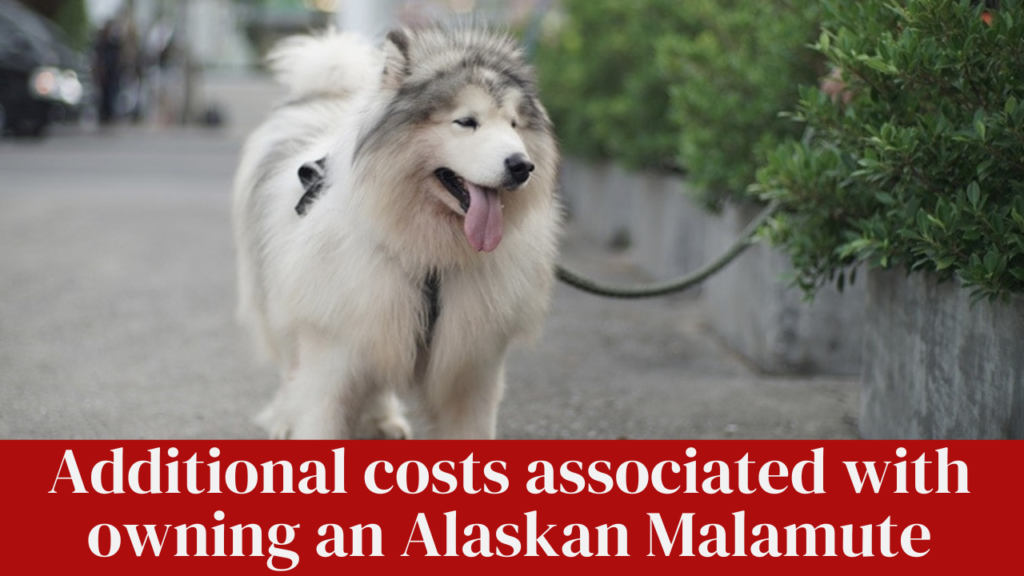
The cost of owning an Alaskan Malamute in India can vary depending on several factors, such as the breeder, location, and availability. In general, Alaskan Malamute price in India from a reputable breeder can be between INR 70,000 to INR 1,50,000 or more. In addition to the initial Alaskan Malamute Price in India, there are also ongoing costs associated with owning an Alaskan Malamute. Some of these additional costs may include:
Food: Alaskan Malamutes are large dogs and can require a significant amount of food. High-quality dog food can cost between INR 4,000 to INR 8,000 per month or more.
Veterinary Care: Regular veterinary check-ups, vaccinations, and preventive care can help keep your Alaskan Malamute healthy. The cost of veterinary care can vary, but you should budget for at least INR 5,000 to INR 10,000 per year.
Grooming: Alaskan Malamutes have a thick, double coat that requires regular grooming to keep it healthy and free of matting. The cost of grooming can vary, but you should budget for at least INR 2,000 to INR 4,000 per month.
Training: Alaskan Malamutes are intelligent dogs that require early training and socialization. The cost of training can vary, but you should budget for at least INR 10,000 to INR 15,000 for basic obedience classes.
Tips for finding a reputable breeder in India
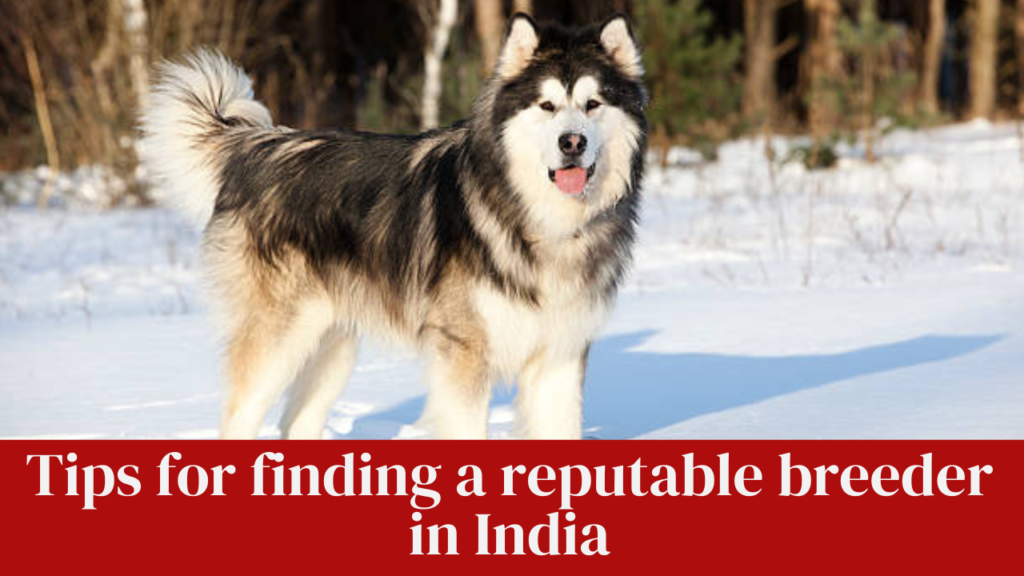
Finding a reputable breeder in India is crucial when looking to bring an Alaskan Malamute into your home. Here are some tips to help you find a responsible and ethical breeder:
Research and Gather Information:
Start by researching different breeders in your area or region. Look for breeders who specialize in Alaskan Malamutes and have a good reputation. Online directories, breed clubs, and forums can provide valuable information and recommendations.
Visit the Breeder in Person:
Once you have a list of potential breeders, arrange to visit them in person. A reputable breeder will be open to having you visit their facilities and meet their dogs. This will allow you to assess the conditions in which the dogs are kept and evaluate their overall health and well-being.
Observe the Dogs and Environment:
During your visit, observe the behavior and temperament of the breeder’s Alaskan Malamutes. They should be well-cared for, clean, and have a friendly disposition. Pay attention to the living conditions, cleanliness, and the breeder’s commitment to providing proper care for their dogs.
You May Also Like
Ask Questions:
Prepare a list of questions to ask the breeder. Inquire about the health testing conducted on their breeding dogs, the lineage and pedigree of the puppies, the socialization process, and any certifications or titles the breeder’s dogs may have obtained. A reputable breeder will be transparent and willingly provide all necessary information.
Health Guarantees and Contracts:
Reputable breeders often provide health guarantees for their puppies, which may include genetic health conditions. They may also require you to sign a contract outlining responsibilities, spaying/neutering requirements, and a return policy if circumstances change and you can no longer care for the dog.
References and Reviews:
Ask the breeder for references from previous puppy buyers. Contact these individuals to inquire about their experience with the breeder and the health and temperament of their Alaskan Malamutes. Additionally, read online reviews and testimonials to gather more information about the breeder’s reputation.
Breeder Involvement and Support:
A responsible breeder will be actively involved in the breed community, such as participating in dog shows or events. They should also be available to offer guidance and support throughout the lifetime of the dog, providing advice on care, training, and any other concerns you may have.
Responsible Breeding Practices:
Inquire about the breeder’s breeding practices, including how often they breed their dogs and the steps taken to ensure the health and well-being of both the parents and puppies. Responsible breeders prioritize the overall health, temperament, and breed standard when planning their litters.
Where to find Alaskan Malamutes for sale in India

If you are interested in purchasing an Alaskan Malamute in India, it is important to do your research and find a reputable breeder. A good breeder will provide you with a healthy puppy that has been socialized and well-cared for.
Here are some ways to find Alaskan Malamutes for sale in India:
Online: You can search for Alaskan Malamutes for sale on online pet marketplaces or classified ad websites. However, it is important to be cautious when purchasing a puppy online and to verify that the breeder is reputable.
Breed Clubs: You can contact breed clubs or associations such as the Kennel Club of India or the Indian Association of Pet Dog Breeders to find a list of registered breeders in India.
Referrals: You can ask for referrals from friends, family members, or other dog owners who have Alaskan Malamutes. They may be able to recommend a reputable breeder or provide you with information about available puppies.
Dog Shows: Attending dog shows or events can be a good way to meet breeders and see Alaskan Malamutes in person. You can also ask breeders for recommendations or referrals to other reputable breeders.
Caring for Alaskan Malamute In India
Caring for an Alaskan Malamute in India requires attention to their specific needs, considering the climate, exercise requirements, grooming, and overall well-being. Here are some essential aspects to consider when caring for an Alaskan Malamute in India:
Climate and Shelter:
- Alaskan Malamutes have a thick double coat designed for cold climates. They may struggle with extreme heat, so it’s crucial to provide them with a cool and shaded area in hot weather.
- Ensure they have access to fresh water at all times to stay hydrated.
- Avoid leaving them outside for extended periods during scorching temperatures.
Exercise and Mental Stimulation:
- Alaskan Malamutes are energetic dogs and require regular exercise to maintain their physical and mental well-being.
- Engage them in daily activities such as brisk walks, jogging, or playing fetch in a secure area.
- Mental stimulation, such as puzzle toys or training sessions, is essential to prevent boredom and destructive behavior.
Grooming:
- Alaskan Malamutes have a dense coat that requires regular grooming to keep it healthy and free of mats.
- Brush their coat at least once or twice a week to remove loose hair and prevent tangles.
- During shedding seasons, which can occur twice a year, more frequent brushing will be necessary.
- Trim their nails regularly and maintain good dental hygiene by brushing their teeth.
Nutrition:
- Provide a balanced and nutritious diet appropriate for their age, size, and activity level.
- Consult with a veterinarian or a canine nutritionist to determine the best feeding plan for your Alaskan Malamute.
- Avoid overfeeding to prevent obesity, which can lead to various health issues.
Veterinary Care:
- Schedule regular check-ups with a veterinarian to monitor your Alaskan Malamute’s health and address any concerns promptly.
- Stay up to date with vaccinations, deworming, and parasite prevention treatments as recommended by your veterinarian.
- Be aware of breed-specific health issues and discuss appropriate screenings with your veterinarian.
Socialization and Training:
- Socialize your Alaskan Malamute from a young age to ensure they are comfortable and well-behaved around people, other animals, and various environments.
- Enroll them in obedience training classes to establish good behavior, manners, and basic commands.
- Positive reinforcement methods work best with this breed, as they respond well to praise, treats, and consistent training techniques.
Mental and Emotional Well-being:
- Alaskan Malamutes thrive on companionship and being part of a family.
- Provide them with plenty of love, attention, and opportunities to interact with their human family members.
- Avoid leaving them alone for extended periods as they can become bored or develop separation anxiety.
Final Thoughts
Alaskan Malamutes are a beautiful and intelligent breed that requires specific care and attention, particularly in a country like India, where the climate and environment can be challenging for them. With proper care and attention to their unique needs, they can thrive and make wonderful companions for their families.
It’s essential to do your research and find a reputable breeder to ensure you are bringing home a healthy and well-bred Alaskan Malamute. Caring for an Alaskan Malamute requires dedication, time, and effort, but the rewards of having such a loyal and loving companion make it all worthwhile.
FAQs
Are Alaskan Malamutes good family dogs?
Yes, Alaskan Malamutes can make great family dogs. They are loyal, affectionate, and playful, and can be good with children if socialized and trained properly. However, due to their size and strength, they should always be supervised when around young children.
How much exercise do Alaskan Malamutes need?
Alaskan Malamutes are active dogs that require regular exercise and activity. They enjoy running, hiking, and other outdoor activities and should be given at least 1-2 hours of exercise per day to keep them happy and healthy.
How much cost is the Alaskan Malamute puppy?
The cost of an Alaskan Malamute puppy can vary depending on factors such as the breeder’s reputation, lineage, quality, and geographical location. On average, you can expect to pay between INR 60,000 to 1,50,000 in India for an Alaskan Malamute puppy.
Why are Alaskan Malamute so expensive?
Alaskan Malamutes are often considered expensive due to several reasons. Firstly, they are a relatively rare breed, and finding a reputable breeder who follows ethical breeding practices can be challenging. Reputable breeders invest significant time, effort, and resources in health testing, proper care, and responsible breeding practices to produce healthy and well-tempered puppies. These factors contribute to the higher cost of Alaskan Malamute puppies.
Is Alaskan Malamute suitable for the Indian climate?
Regarding the Indian climate, Alaskan Malamutes may face challenges due to their thick double coat, which is designed for colder climates. The hot and humid conditions in many parts of India can be uncomfortable for them. It is important to provide them with proper shelter, access to cool areas, and freshwater to help them cope with the heat. Additionally, you should avoid leaving them outside for extended periods during scorching temperatures. While it is possible to keep an Alaskan Malamute in India with proper care and management, extra precautions and attention to their well-being are necessary.
How long will a Malamute live?
The lifespan of an Alaskan Malamute typically ranges from 10 to 14 years. However, individual factors such as genetics, overall health, diet, exercise, and quality of care can influence their lifespan. Providing a balanced diet, regular veterinary care, proper exercise, and a loving environment can contribute to a longer and healthier life for your Alaskan Malamute.
Are Alaskan Malamutes easy to train?
Alaskan Malamutes can be somewhat challenging to train due to their strong-willed and independent nature. They require consistent and patient training from an early age, and may benefit from professional obedience training or socialization classes.
Are Alaskan Malamutes good with other pets?
Alaskan Malamutes can be good with other pets if socialized properly from a young age. However, due to their strong prey drive, they may be more likely to chase and potentially harm smaller animals like cats or rabbits.



